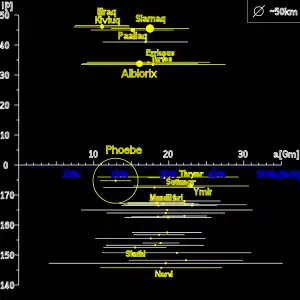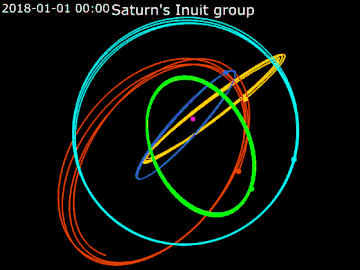Saturn's Inuit group of satellites
The Inuit group is a dynamical grouping of the prograde irregular satellites of Saturn which follow similar orbits. Their semi-major axes range between 11 and 18 Gm, their inclinations between 40° and 50°, and their eccentricities between 0.15 and 0.48. They take about 2 years to orbit Saturn.

The International Astronomical Union (IAU) uses names taken from Inuit mythology for these moons.
The group appeared quite homogeneous in early observations, the satellites displaying light-red colour (colour indices B−V = 0.79 and V−R = 0.51, similar to that of the Gallic group)[1] and similar infrared spectra.[2] Recent observations, however, revealed that Ijiraq is distinctly redder than Paaliaq, Siarnaq and Kiviuq. In addition, unlike the other three, Ijiraq's spectrum does not display weak absorption near 0.7 μm. This feature is attributed to a possible water hydration.[3]
The spectral homogeneity (with the exception of Ijiraq) is consistent with a common origin in the break-up of a single object but the dispersion of the orbital parameters requires further explanation. Recently reported secular resonances among the members could provide the explanation of the post-collisional dispersion.
The discovery of two new moons in this group was announced in October 2019. A team led by Scott S. Sheppard using the Subaru Telescope at Mauna Kea discovered 20 new moons, each about 5 kilometres (3.1 mi) in diameter. A public naming contest for these moons will be restricted to names from Inuit mythology.[4]
Names
The members of the group discovered before 2019 are (in order of increasing distance from Saturn):
References
- Grav, Tommy; Holman, Matthew J.; Gladman, Brett J.; Aksnes, Kaare Photometric survey of the irregular satellites, Icarus, 166,(2003), pp. 33–45. Preprint
- Tommy Grav and Matthew J. Holman Near-Infrared Photometry of the Irregular Satellites of Jupiter and Saturn,The Astrophysical Journal, 605, (2004), pp. L141–L144 Preprint
- Tommy Grav and James Bauer A deeper look at the colors of Saturnian irregular satellites, Preprint
- Saturn surpasses Jupiter after the discovery of 20 new moons—and you can help name them, NASA, phys.org, October 7, 2019

